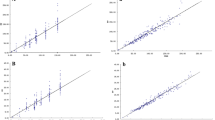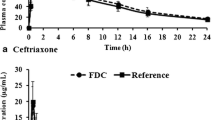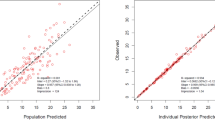Abstract
This study aimed to explore the pharmacokinetic features of levofloxacin (LVFX) in Chinese patients with infections and to confirm oral LVFX 500 mg once daily as an optimal treatment regimen based on pharmacokinetic-pharmacodynamic (PK-PD) analysis. A total of 1052 plasma samples from 164 Chinese adult patients with communityacquired lower respiratory tract infections (CALRTIs) and 18 healthy volunteers were used for population PK analysis. LVFX 500-mg tablets were given once daily. A nonlinear mixed effects model (NONMEM) program was used for population PK model-building and a two-compartment model with first-order absorption process was established. Creatinine clearance (CLcr) and body weight were identified as intrinsic factors which significantly affected oral clearance (CLt/F) and the apparent volume of distribution of the central compartment (V1/F), respectively. The final model is described as follows: CLt/F (l/h) = (8.97 + 0.917 × (CLcr (ml/min) − 100.92) × 60/1000) × exp (ηCLt/F). V1/F (l) = (85.3 + 1.22 × (weight (kg) − 60.75)) × exp (ηV1/F). Q/F (l/h) = 0.351. V2/F (l) = 6.81. ka (h−1) = 1.44 × exp(ηka). Based on the population PK model, mean Cmax and AUC0–24h in CALRTI patients were estimated as 5.13 µg/ml and 58.98 µg·h/ml, respectively. A subgroup analysis showed that patients with mild renal dysfunction (50 ml/min ≤ CLcr < 80 ml/min) had 34% higher AUC0–24h values compared to patients with normal renal function (CLcr ≥ 80 ml/min). Postmodeling simulation using final population PK estimates also showed that Cmax and AUC0–24h increased markedly in patients with severe renal dysfunction. The results indicate that LVFX dosage adjustment should be individualized on the basis of the CLcr, especially in those with CLcr less than 50 ml/min. None of the PK parameters had any correlation with the occurrence of adverse events. PK-PD analysis indicated that, in patients treated with LVFX 500 mg once daily, the AUC0–24h/MIC ratio exceeded the target for those major CALRTI pathogens isolated. In addition, the Cmax/MIC ratio reached 5 for Streptococcus pneumoniae, indicating that the emergence of LVFX-resistant S. pneumoniae could be prevented during the therapy with this dosage regimen. These results demonstrate that oral LVFX 500 mg once daily has favorable PK parameters and PK-PD features in patients with CALRTIs, and the results strongly support this dosage regimen for the treatment of CALRTI.
Similar content being viewed by others
References
Boselli E, Breilh D, Rimmelé T, Djabarouti S, Saux MC, Chassard D, et al. Pharmacokinetics and intrapulmonary diffusion of levofloxacin in critically ill patients with severe community-acquired pneumonia. Crit Care Med 2005;33:104–109.
Capitano B, Mattoes HM, Shore E, O’Brien A, Braman S, Sutherland C, et al. Steady-state intrapulmonary concentrations of moxifloxacin, levofloxacin, and azithromycin in older adults. Chest 2004; 125:965–973.
Gotfried MH, Danziger LH, Rodvold KA. Steady-state plasma and intrapulmonary concentrations of levofloxacin, and ciprofloxacin in healthy adult subjects. Chest 2001;119:1114–1122.
Rodvold KA, Danziger LH, Gotfried MH. Steady-state plasma and bronchopulmonary concentrations of intravenous levofloxacin and azithromycin in healthy adults. Antimicrob Agents Chemother 2003;47:2450–2457.
Shams WE, Evans ME. Guide to selection of fluoroquinolones in patients with lower respiratory tract infections. Drugs 2005;65: 949–991.
Croom KF, Goa KL. Levofloxacin: a review of its use in the treatment of bacterial infections in the United States. Drugs 2003;63: 2769–2802.
Madaras-Kelly KJ, Demasters TA. In vitro characterization of fluoroquinolone concentration/MIC antimicrobial activity and resistance while simulating clinical pharmacokinetics of levofloxacin, ofloxacin, or ciprofloxacin against Streptococcus pneumoniae. Diagn Microbiol Infect Dis 2000;37:253–260.
Preston SL, Drusano GL, Berman AL, Fowler CL, Chow AT, Dornseif B, et al. Pharmacodynamics of levofloxacin: a new paradigm for early clinical trials. JAMA 1998;279:125–129.
Blondeau JM, Zhao X, Hansen G, Drlica K. Mutant prevention concentrations of fluoroquinolones for clinical isolates of Streptococcus pneumoniae. Antimicrob Agents Chemother 2001;45: 433–438.
Zhang YY, Huang HH, Ren ZY, Zheng JG, Yu YS, Lu XJ, et al. Clinical evaluation of oral levofloxacin 500 mg once daily for treatment of lower respiratory tract infections and urinary tract infections: a prospective multicenter study in China. J Infect Chemother 2009;15:301–311.
Okazaki O, Aoki H, Hakusui H. High-performance liquid chromatographic determination of (S)- (−) — ofloxacin and its metabolites in serum and urine using a solid-phase clean-up. J Chromatogr 1991;563:313–322.
Beal SL, Sheiner LB. The NONMEM system. Am Stat 1980;34: 118–119.
Cockcroft DW, Gault MH. Prediction of creatinine clearance from serum creatinine. Nephron 1976;16:31–41.
Fish DN, Chow AT. The clinical pharmacokinetics of levofloxacin. Clin Pharmacokinet 1997;32:101–119.
Lacy MK, Lu W, Xu X, Tessier PR, Nicolau DP, Quintiliani R, et al. Pharmacodynamic comparisons of levofloxacin, ciprofloxacin, and ampicillin against Streptococcus pneumoniae in an in vitro model of infection. Antimicrob Agents Chemother 1999;43: 672–677.
Craig WA. Does the dose matter? Clin Infect Dis 2001;33:233–237.
Author information
Authors and Affiliations
Corresponding author
About this article
Cite this article
Zhang, J., Xu, Jf., Liu, Yb. et al. Population pharmacokinetics of oral levofloxacin 500 mg once-daily dosage in community-acquired lower respiratory tract infections: results of a prospective multicenter study in China. J Infect Chemother 15, 293–300 (2009). https://doi.org/10.1007/s10156-009-0714-8
Received:
Accepted:
Published:
Issue Date:
DOI: https://doi.org/10.1007/s10156-009-0714-8




